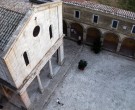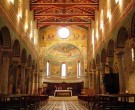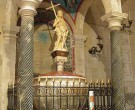> Home > What to visit > Churches and Monasteries

Cattedrale di San Secondiano Chiusi
CHURCHES AND MONASTERIES
.jpeg)
PHONE NUMBERS AND TIMES
Cattedrale di San Secondiano
Via Porsenna 53043 Chiusi
Business card (vCard)
The Cathedral is unique, due to its isolated bell tower, built in 1585, originally a defensive tower. Under the tower, 12 meter deep, there’s a Roman pool, dated 1st century B.C. made up of two spaces with barrel vaults.
The Cathedral, that dates back to the VIth century and that was transformed in the XIIth century, endured huge restoration works during the period of Bishop Giuseppe Pannilini, from 1775 to 1822. Later, it was drastically restructured, from 1887 to 1894, under the direction of Giuseppe Partini. These last restructuring works, brought to the restoration of the facade, preceded by a Doric portico, that distinguishes itself for the architectural structure that unites Roman Paleochristian styles to Byzantine-Ravenna motives.
The diggings, executed during the seventies, in the presbytery area, have brought to light a building , under the present one, built over the ruins of a more ancient construction. It’s a cathedral with a three nave plan with four sided columns, with painted plastered walls and a mosaic pavement, dated between the end of the IVth century and the beginning of the Vth century. The cathedral was later rebuilt in the middle of the VIth century, partially recovering the architectural elements of the ancient cathedral.
The interior follows a basilican plan with three large naves divided by eighteen different columns recovered from more ancient constructions, maybe Roman. The columns, in marble and travertine with dif capitals,that present different styles, remind us of the first primitive Paleochristian construction, followed by the Renaissance restoration and later by the reconstruction in the 1800s. On the third column on the left, the name of Bishop Florentino is engraved, allowing us to date the building 558-560. Over the arcades, eight large windows open up on each side.
The naves were reopened during the works executed between 1884 and 1894. The walls of the central nave, part of the counter facade and the apsis have been painted as false Roman and Ravenna mosaic by the Sienese Arturo Viligiardi at the end of 1800. According to a complex iconographic program, in the central nave, two groups of martyr saints, either buried in the catacombs in Chiusi or tied to the historical events of Saint Mustiola are represented on the left and right side of the nave The paintings in the apsis, dated 1892, draw inspiration from the mosaics in the Cathedral of Santa Maria Maggiore in Rome. The one on the right represents Martyr Orsola (1894), while the one on the left represents Saint Catherine of Alexandria.
On the right and left side of the central entrance there are two epigraphs that Sinebuto, successor of Bishop Montano(731-740) had engraved. Entering, immediately on the right, there’s a niche, painted by Arturo Viligiardi, supported by two Roman columns, that come from the destroyed church of Santa Mustiola, and that previously belonged to the ciborium, erected by Duke Gregory around 728. Inside, there is a monolithic basin in marble that creates the baptismal font , surmounted by a statue of Saint John the Baptist. In the left nave, there’s Saint Mustiola’s cenotaph, made of a stone urn, where in 1474 the Saint’s mortal remains were placed, together with the ancient fictile urn, after the body was exhumed from the Vth century sepulchre, placed behind the major altar of the destroyed church of Saint Mustiola. The two columns and the travertine stone of the cenotaph are recycled material from the church of Saint Mustiola.
In 1785, a new major altar was built that should have hosted Saint Mustiola’s urn; altar, that , in the seventies, was transferred to the sacristy, to allow the diggings in the presbytery. The two fragmented, architectural elements in stone, preserved on the sides of the major portal, are probably the only pieces that remain of the original altar. In the presbytery, there’s a wooden carved choir, dated 1660. The chapel of the Holy Sacrament, that opens up in the nave on the left side, was built in 1801; inside there’s the altar screen with the Adoration of the Child between Saint Secondiano and Saint Girolamo, painted by the Sienese Bernardino Fungai ( early XVth century).
The chapel of the Virgin opens up on the right side. It was originally dedicated to Saint Catherine of Siena and commissioned by Bishop Alfonso Petrucci , that wanted to be buried under its pavement. The fresco on the altar was created by Arturo Viligiardi. It represents Saint Catherine, that miracoulously learns to read (1893).
STAY NEARBY
LA BADIOLA
CHIUSI
Large farmhouse immersed in the romantic setting of the Sienese countryside provides hospi...LA FATTORIA
CHIUSI
The Fattoria is an old farmhouse of the 18th century situated in a particuraly quiet place...DEL SOLE
CHIUSI
L 'hotel Del Sole è un piccolo albergo immerso nel verde delle colline toscane, sit...DINING & ENTERTAINMENT NEARBY
Teatro Mascagni
CHIUSI
A dare i natali al teatro di Chiusi è l'Accademia dei Filateti, fondata nel 1818 e ...Clev Village Multisala
CHIUSI
...Teatro degli Arrischianti
SARTEANO
Il Teatro Comunale degli Arrischianti di Sarteano è all'interno del Palazzo Comuna...



.jpeg)

.jpeg)

.jpeg)


